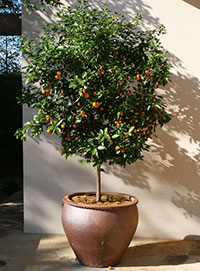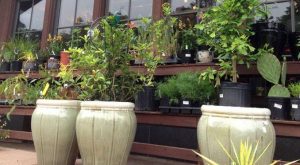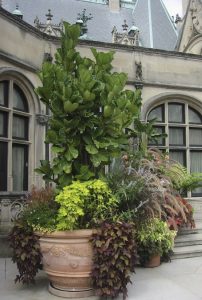Containerized Trees — Small-Spaced with Big Effects
Part One: Start with the Right Site and Right Container
By Elizabeth Cornell Fake. Fairfax Master Gardener
 Containerized trees have become increasingly popular for many of the same reasons gardeners have become enthusiastic about container flower gardens. If you have limited space, poor soil, limited sun exposure or water supply, and you want landscape effects in your garden, you may want to consider growing a tree in a container. Containerized trees are also portable, when sized appropriately, and can spend the summer outside and winter inside.
Containerized trees have become increasingly popular for many of the same reasons gardeners have become enthusiastic about container flower gardens. If you have limited space, poor soil, limited sun exposure or water supply, and you want landscape effects in your garden, you may want to consider growing a tree in a container. Containerized trees are also portable, when sized appropriately, and can spend the summer outside and winter inside.
Many of the same principles that apply to container flower gardens apply to containerized trees as well. But, given the cost of trees and suitable containers, it is important to review the principles as they apply specifically to trees. They include: site selection, type of container and supporting soil, tree selection, planting and maintenance.
Site Selection — Environmental factors play a dominant role in the life of a containerized tree because a tree in a container does not have the same root development as an inground specimen. For this reason, the decision of where to locate the container drives most of the other decisions you will make. Containerized trees require a sunny location with a minimum of four hours of direct sunlight. If you plan to locate the tree on a high-rise balcony, remember that trees in containers are far more sensitive to cold than inground planted trees. A good rule of thumb is to subtract one climate zone for container planting and subtract an additional zone for floors beyond the tenth level. For a Virginia gardener in Zone 7, that means your tree selection should be hardy to Zone 5.
Container and Supporting Soil — Considerations for choosing a container are both practical and aesthetic. First of all, make sure your container is large enough to support the root structure of the tree. It should also have some extra room for root growth. Measure the size of the root ball and add 12 to 16 inches for additional growth. As the tree grows, you should plan to repot it in a larger container.

Ceramic containers

Terracotta container with pan
Use a potting mix from a garden center as your choice for supporting soil. Since good drainage is a major factor in the success of a containerized tree, avoid using soil from an outside garden regardless of how well it has been conditioned for other projects. Look for a soil mixture that contains pine bark, compost, sand and expanded clay shards. Be careful using peat moss as it dries out and cannot be rehydrated.
Now you are ready to plant your tree. See Part Two of this series, The Right Tree in the Right Place with the Right Care for more information next month.
Resources
Trees for Landscape Containers and Planters, Virginia Cooperative Extension, Publication 430-023
Growing Fruit Crops in Containers, University of Florida IFAS Extension, Publication # HS57, 2016
Growing Trees in Containers, The National Gardening Association, Learning Library, n.d.